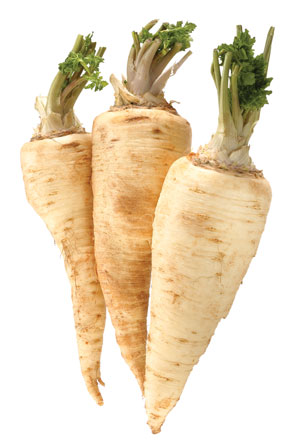
Michigan Fresh: Using, Storing, and Preserving Parsnips (HNI44)
DOWNLOADJuly 17, 2023 - Christine Venema, Michigan State University Extension
This Document is offered in: English, Arabic Espanol,
Yield
|
4 medium (1 pound) = |
2 cups diced and cooked |
Food Safety and Storage

- Pick or purchase parsnips that are not bruised or damaged.
- Wash hands before and after handling fresh produce.
- Wash parsnips under cool running water using a vegetable brush. Do not use soap.
- Keep parsnips away from raw meat and meat juices to prevent cross-contamination.
- For best quality and to preserve nutrients, preserve no more than your family can consume in one year.
- Parsnips are best if stored in cold, moist storage – at temperatures between 32 degrees and 40 degrees F with a relative humidity of 90 to 95 percent. The colder part of the refrigerator offers this range of temperatures. To maintain a high relative humidity, put the parsnips in a plastic bag or place parsnips unbagged in the vegetable crisper of the refrigerator, which should be more than half full of Remove excess water or allow it to evaporate before storing. The average storage life of parsnips using this method is 2 to 6 months.
- Parsnips should be left in the ground until their tops freeze in late fall — the flavor becomes sweeter when the roots are exposed to temperatures below 40 degrees F.
- Unharvested roots may be left in the ground to be used during the winter.
- Small- and medium-width roots have the best flavor and texture. Large roots tend to be woody and fibrous
How to Preserve
Parsnips may be canned, but freezing results in a better product.
Freezing
Choose small to medium-sized parsnips so they will be tender and not woody. Remove the tops, wash, peel and cut into ½-inch cubes or slices. It may be necessary to remove a fibrous core. Heat the parsnips in boiling water for 2 minutes. Cool the parsnips in ice water for 2 minutes and drain. Do not leave water droplets on the parsnips — these will cause freezer burn to occur. Pack into containers, leaving ½-inch headspace. Seal, label, date, and freeze.
Canning
Pressure canning is the only safe method of canning parsnips. Parsnips must be pressure canned to avoid the potential of the foodborne illness botulism.
Hot pack
Wash parsnips, scrubbing them very well. Peel, remove fibrous core, slice, or dice the parsnips. Place the parsnips in a saucepan, cover with boiling water and boil for 5 minutes. Pack hot pieces into hot jars leaving 1-inch headspace. If desired, add ½ teaspoon of salt to pints; 1 teaspoon of salt to quarts. Fill each jar to 1 inch from the top of the jar with boiling hot cooking liquid. Remove air bubbles; adjust headspace if needed. Wipe jar rims with clean paper towel. Adjust the lids and process (see tables that follow for recommended processing times).
|
Recommended process time (in minutes) for parsnips in a dial-gauge pressure canner. |
||||||
|
|
Canner pressure (PSI) at altitudes of |
|||||
|
Style of pack |
Jar size |
Process time |
0 - 2,000 ft |
2,001 - 4,000 ft |
4,001 - 6,000 ft |
6,001 - 8,000 ft |
|
Hot |
Pints |
30 |
11 lb. |
12 lb. |
13 lb. |
14 lb. |
|
Quarts |
35 |
11 lb. |
12 lb. |
13 lb. |
14 lb. |
|
|
Recommended process time (in minutes) for parsnips in a weighted-gauge pressure canner. |
||||
|
|
Canner pressure (PSI) at altitudes of |
|||
|
Style of pack |
Jar size |
Process time |
0 - 1,000 ft |
Above 1,000 ft |
|
Hot |
Pints |
30 |
10 lb. |
15 lb. |
|
Quarts |
35 |
10 lb. |
15 lb. |
|
Let jars stand undisturbed for 12 to 24 hours, remove rings, check to make sure lids are sealed, wash jars, label, date and store. Food in jars that do not seal must be reprocessed in a clean jar with a new lid within 24 hours, refrigerated or frozen.
Tables were adapted from the information in Andress, E., & Harrison, J. A. (2014). So easy to preserve (Bulletin 989). (6th ed.). University of Georgia Cooperative Extension.
References
- Albrecht, J. A., Browning, S., & Stoner, N. (2016). Storing fresh fruits and vegetables. University of Nebraska, Lincoln, Institute of Agriculture and Natural Resources.
- Andress, E., & Harrison, J. A. (2014). So easy to preserve (Bulletin 989). (6th ed.). University of Georgia Cooperative Extension.
- Michigan State University Extension. (2022). How much should I buy? A guide to fresh fruits and vegetables for home cooking. https://www.canr.msu.edu/resources/how_much_ should_i_buy
- Robbins, J. A., Colt, W. M., & Raidl, M. (2012). Harvesting and storing fresh garden vegetables. (Bulletin 617). University of Idaho Extension.
More information



 Print
Print Email
Email




